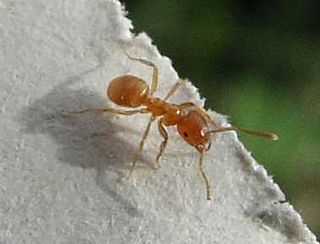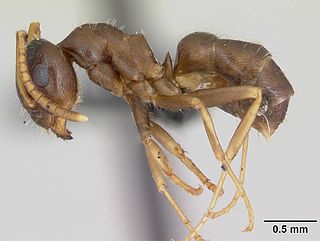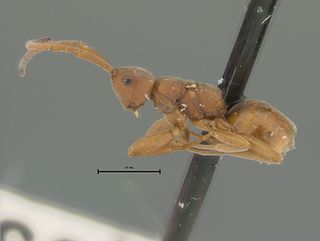Related Research Articles

Lasius is a genus of formicine ants. The type species for this genus is the black garden ant, Lasius niger. Other major members, which live in drier heathland, are the cornfield ant, L. neoniger, and L. alienus. Other species include the temporary social parasites of the L. mixtus group and the hyper-social parasite Lasius fuliginosus. Lasius flavus is also a commonly seen species, building grassy hillocks in undisturbed pasture. In the Alps, these mounds - always aligned east to catch the first rays of the rising sun - have been traditionally used by goatherds as natural compasses.

The black garden ant, also known as the common black ant, is a formicine ant, the type species of the subgenus Lasius, which is found across Europe and in some parts of North America, South America, Asia and Australasia. The European species was split into two species; L. niger, which are found in open areas; and L. platythorax, which is found in forest habitats. It is monogynous, meaning colonies contain a single queen.

The yellow meadow ant,, is one of the most common ants in Central Europe, and it also occurs in Asia and North Africa, but populations in North America are a different, related species.

Xanthogramma pedissequum is a species of hoverfly.

Lasius neglectus is a polygynous, sometimes invasive, ant of the genus Lasius. The ant was identified in 1990 after establishing a colony in Budapest, Hungary. Superficially, they are similar in appearance to the common black garden ant, Lasius niger, but have significantly different behavioural patterns, particularly in the social structure within colonies.

Lasius umbratus, colloquially known as the yellow shadow ant and yellow lawn ant, is a palearctic species of parasitic ant distributed across Eurasia and the Maghreb region of Africa. It was once thought that this species occurred in North America as well, but comparative genomic studies indicate the Afro-Eurasian and American populations are discrete and not closely related enough to represent a single species. The North American populations are now treated as a different species, Lasius aphidicola.
Myrmozercon is a genus of mites in the family Laelapidae.

Antennophorus is a genus of mites in the family Antennophoridae. It was described by Haller in 1877.
L. flavus may refer to:
L. grandis may refer to:
Pseudacteon formicarum is a kind of parasitic species of flies from the family of Phoridae of the subfamily Metopininae.

Lasius alienus, or cornfield ant, is a species of ant in the subfamily Formicinae. Workers have a length of about 2–4 mm, Queens are larger (7–9 mm).

Lasius fuliginosus, also known as the jet ant or jet black ant, is a species of ant in the subfamily Formicinae. Workers have a black shiny colour and a length of about 4–6 mm, females are larger (6–6.5 mm) and small males reach a length of 4.5–5 mm). The head is heart-shaped.

Delplanqueia dilutella is a species of moth in the family Pyralidae. It was described by Michael Denis and Ignaz Schiffermüller in 1775. It is found in most of Europe, east to Russia, Turkey, Iran and Mongolia.

Platyarthrus hoffmannseggi is a species of woodlouse which is closely associated with ants' nests, particularly those of Lasius flavus, Lasius niger and species of Myrmica, where it feeds on ant droppings or mildew. It is white, 4 millimetres (0.16 in) long, and has a distinctive oval shape and short antennae. Its distribution appears to follow those of the ants with which it lives, and the British Isles are the north-westerly limit of its range. Elsewhere, P. hoffmannseggii extends south to the Mediterranean Sea. It is found outside Europe in North Africa and Turkey, and has been introduced to Australia and North America.

Claviger is a genus of beetles in the family Staphylinidae, subfamily Pselaphinae. About 40 species and subspecies are described, divided into two subgenera, Claviger (Claviger) and Claviger Clavifer. Claviger displays unusual biological adaptations to myrmecophily. This pselaphid is of palearctic distribution.

Many species of Staphylinidae have developed complex interspecies relationships with ants, known as myrmecophily. Rove Beetles are among the most rich and diverse families of myrmecophilous beetles, with a wide variety of relationships with ants. Ant associations range from near free-living species which prey only on ants, to obligate inquilines of ants, which exhibit extreme morphological and chemical adaptations to the harsh environments of ant nests. Some species are fully integrated into the host colony, and are cleaned and fed by ants. Many of these, including species in tribe Clavigerini, are myrmecophagous, placating their hosts with glandular secretions while eating the brood

Embolemidae is a small family of around 64 species and 3 genera distributed around the world. They are small solitary parasitoid wasps, and are parasites on planthopper nymphs of the families Achilidae and Cixiidae.
References
- ↑ Joel Hallan (ed.). "Antennophoridae Species Listing". Biology Catalog. Texas A&M University. Archived from the original on 7 August 2010. Retrieved September 10, 2010.
- ↑ N. R. Franks, K. J. Healey & L. Byrom (1991). "Studies on the relationship between the ant ectoparasite Antennophorus grandis (Acarina: Antennophoridae) and its host Lasius flavus (Hymenoptera: Formicidae)". Journal of Zoology . 225 (1): 51–67. doi:10.1111/j.1469-7998.1991.tb03801.x.